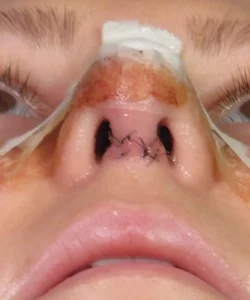
Maintaining a clean incision line following open rhinoplasty surgery is one of the keys to achieving an ideal outcome. This is so important that my staff and I will emphasize proper cleaning technique verbally and in writing – repeatedly. Unfortunately, despite redundant discussions, including black and white handouts, a good number of patients will still present 5-7 days out from rhinoplasty with suboptimal care of their incision line.
Previously we have added a video that shows proper rhinoplasty incision cleaning, but this point cannot be emphasized enough. I added this blog entry into our rhinoplasty tutorial as a reinforcement so that patients can visually see what the goal is when cleaning an open rhinoplasty incision line.
This photo is one of my past rhinoplasty patients who had done a particularly good job in terms of cleaning her open rhinoplasty incision. She is just a few days out from the surgery and demonstrates what proper cleaning technique can accomplish.
It really distills down to a 3-step process when cleaning your rhinoplasty incision. First, you clean the suture line and incision using a q-tip saturated in hydrogen peroxide. There should be a sufficient amount of hydrogen peroxide that allows for thorough chemical cleaning of any dried blood or debris. You should also take care to avoid getting any fibers of the cotton tip stuck on the sutures. If this occurs, you must clean these off as well. This may require you to gently rub the incision line, but you should not, by any means, be heavy-handed when doing this – as you will risk damaging the actual underlying surgical alterations that were made. Second, you should dry the incision line with a new q-tip so that the hydrogen peroxide is removed. Third, you should apply a thin layer of bacitracin ointment – not neomycin – along the entire area that was just cleaned. If you do this properly, this cleaning should only be done 3-4 times per day. If you are doing it more frequently than 3-4 times per day – you are not doing it correctly.
The endpoint of rhinoplasty incision cleaning is to clearly see the suture tails and knot (the black material in the adjacent photo) along with surrounding skin. There should be no scabbing, dried blood, crusting or other debris around the sutures and incision. This includes absence of any of this within the nostril opening. This, too, should be incredibly clean.
If your open rhinoplasty incision does not look like this – you are doing something wrong and you will risk having a less than optimal scar once all healing has occurred. In some cases, improper cleaning of the incision line can also lead to other complications, such as wound infection and distortion of the nasal shape.
I hope this additional information will help that minority of rhinoplasty patients who need added guidance when it comes to cleaning their incisions.
